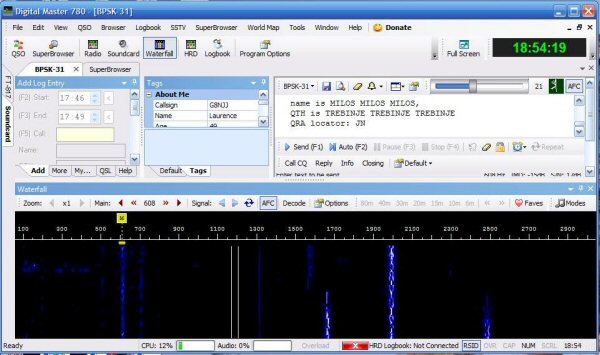What’s a “Digital Mode”?
For countless years, amateurs have been using Radio Teletype (RTTY) to exchange messages. A common arrangement used to be to buy a mechanical teleprinter, which had a very simple “on/off” bit stream output. You’d then either buy or make a (complex) radio interface that generated an audio signal to encode or decoder the RTTY bit stream. The audio signals connected to your radio and hey presto- a two way data link was born. Conventional RTTY was the mainstay of all manner of long distance communications for amateurs and professionals alike.
Many of us own one or more personal computers (PCs). Modern computers have microphone and speaker ports; some long time ago clever people realised that a PC would be able to encode and decode RTTY signals, avoiding the expensive interface. In receive mode, the microphone input to the PC is connected to your radio and a program decodes the audio to generate the text being typed at the far end. In transmit mode, the PC creates an audio signal as you type and it connects to your radio microphone input. No more teletype needed!
The original RTTY standard is still in use today. It uses what is called “Frequency Shift Keying” and uses two tones, typically separated by 170Hz. While it met the requirements and technology of the day, it uses rather more spectrum than necessary for what is a fairly low data rate. Peter Martinez, G3PLX devised a new scheme called “PSK31” which does a very similar job but with much lower error rates, and fitting into a 31Hz channel: modern digital modes were born. Today there are many different data modes, although PSK31 is probably the most common. What’s less widely known is that PSK31 is more spectrally efficient than morse, and can achieve more than twice the range at the same power level.
Some data modes deal with more than just typing. Slow Scan TV encodes images onto a relatively low bandwidth data stream; and there are messaging systems akin to email. Modern PC programs can generate and decode a very wide range of theses modes. You don’t even need a PC; there are “apps” that run on modern smartphones that do this. Just put the phone by the radio speaker and it will begin to decode.
How do I use them?
There are many PC programs available for amateur digital modes, and most of them are free. The one I’ve used is called “Digital Master” and is part of the well known “Ham Radio Deluxe” package, but there are many others. To get started, you will need this equipment:
- A transceiver with an SSB audio mode
- A PC, running one of the common programs
- A PC audio interface to your transceiver
The latest ICOM radios have a USB interface built in, which will support data modes directly. For other rigs the audio interface isn’t complicated. All that’s needed is to get speaker audio from your radio to the PC “microphone” input, and vice versa. It’s generally preferred to use transformer coupling, to avoid possible ground loops. Even putting the PC microphone near the radio’s speaker will work. You will need a way to switch the radio between TX and RX; that can be manually, using VOX or using the PC interface. You can buy an interface that does all this: for example the “Signalink” interface products provide the audio interface and a separate “cat” control to allow the PC to control the radio directly. Or you can make a simple interface - many designs exist. For example see PW March 2012, or my FT817 interface or FT450 interface. If it’s costing much over £10, then it’s more complicated than it could be.
The software is pretty easy to get started. Tune your radio to USB, on one of the bandplan frequencies for PSK31: for example 14.070MHz on 20m. The software will show a “waterfall” display with the audio spectrum from 0 to around 3KHz across the screen. The display slowly scrolls down, and you use that display to find out what modes and transmissions are present. There are seven distinct QSOs in the screenshot below.
A typical data mode will look like a thin “ribbon” running down the screen. Click on the ribbon to tell the software which signal you want and it will start to decode it. Although you can see – and hear – the whole SSB audio channel, the PC tunes a software based decoder with a much narrower bandwidth. There can be dozens of active signals in the SSB channel. To transmit, type into the box and the program will generate the audio stream; if there is a suitable connection, it will put your radio into TX mode while you type.

You’ll need to adjust the audio level on TX to make sure the amplifier stays linear. Avoid any ALC indication, if your rig indicates that. The amplifier will get hot, because it is being driven flat out. Back off the power – you don’t need much with modern modes.
